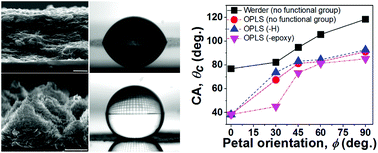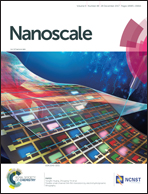Superhydrophobic inkjet printed flexible graphene circuits via direct-pulsed laser writing†
Abstract
Solution-phase printing of exfoliated graphene flakes is emerging as a low-cost means to create flexible electronics for numerous applications. The electrical conductivity and electrochemical reactivity of printed graphene has been shown to improve with post-print processing methods such as thermal, photonic, and laser annealing. However, to date no reports have shown the manipulation of surface wettability via post-print processing of printed graphene. Herein, we demonstrate how the energy density of a direct-pulsed laser writing (DPLW) technique can be varied to tune the hydrophobicity and electrical conductivity of the inkjet-printed graphene (IPG). Experimental results demonstrate that the DPLW process can convert the IPG surface from one that is initially hydrophilic (contact angle ∼47.7°) and electrically resistive (sheet resistance ∼21 MΩ □−1) to one that is superhydrophobic (CA ∼157.2°) and electrically conductive (sheet resistance ∼1.1 kΩ □−1). Molecular dynamic (MD) simulations reveal that both the nanoscale graphene flake orientation and surface chemistry of the IPG after DPLW processing induce these changes in surface wettability. Moreover, DPLW can be performed with IPG printed on thermally and chemically sensitive substrates such as flexible paper and polymers. Hence, the developed, flexible IPG electrodes treated with DPLW could be useful for a wide range of applications such as self-cleaning, wearable, or washable electronics.



 Please wait while we load your content...
Please wait while we load your content...